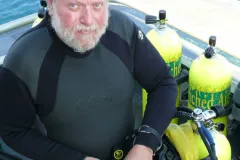Peter Auster: The Gee Whiz Factor

I still haven’t gotten beyond the ‘gee whiz’ factor of studying communities of animals in deep-sea coral habitats. Climbing over undersea mountains and along the steep cliffs of submarine canyons using subs and ROVs, I’ve had the opportunity to see some species of deep-sea fishes alive for the very first time. They do some pretty cool things to survive, and they live amongst an incredible diversity of deep-sea life.
I’ve also seen places that have been devastated by human activities. The impacts from human uses are accelerating. How are fishing and other kinds of human activities affecting deep-sea corals? How do we decide where to conduct certain activities and where fully protected areas should be? I want to continue doing the exploration and research necessary to help inform those critical decisions.
Pretty Incredible Places
Exploration and research usually require that I’m on ship pretty far offshore. Sometimes we use tethered robots, or ROVs, to explore deep-sea coral communities and the ocean floor. Other times we climb into a research submarine.
Dropping down to seafloor is like parachuting into a different world. During one dive to the Atlantic Ocean’s Manning Seamount, someone described the landscape as ‘Dr. Seuss’s garden’ because there were such amazing otherworldly shapes and colors among the diversity of corals, sponges, fishes, and other species. These are pretty incredible places. We have a duty to conserve and protect them. I believe if people had the opportunity to see and understand that such places exist, they would want to do this, too.

